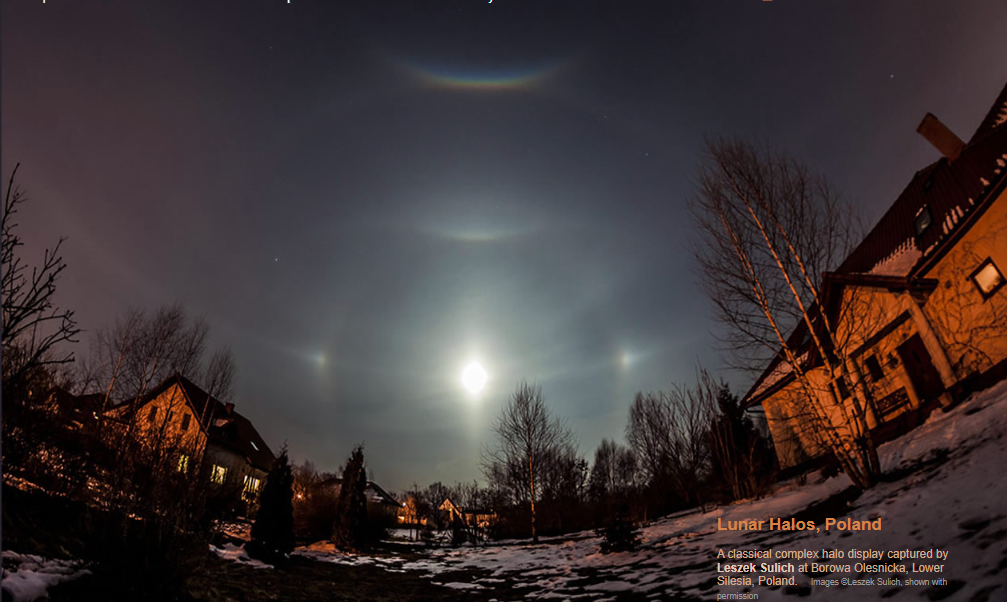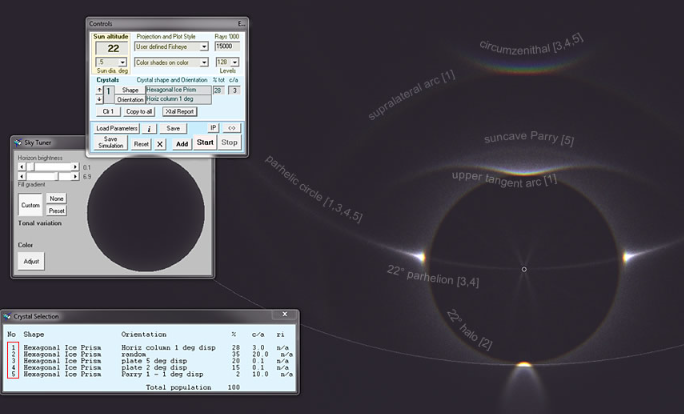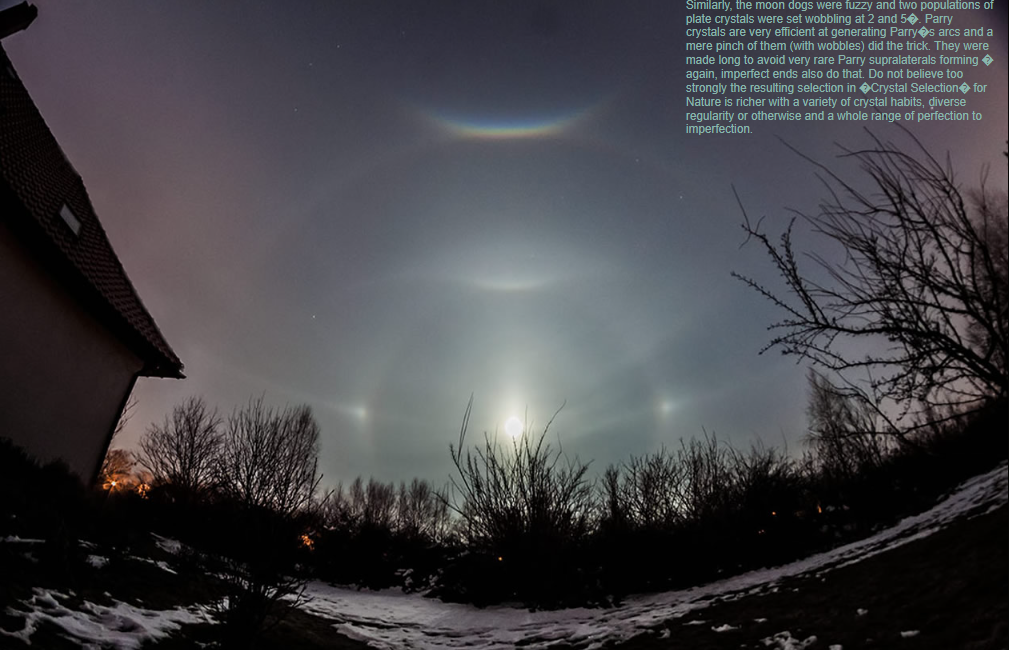OPOD - Moon Halo Display, Poland
Moon Halo Display in Poland: A Spectacular Atmospheric Phenomenon
In the realm of atmospheric optics, few displays are as captivating as lunar halos. One such display was recently captured by Leszek Sulich in Borowa Olesnicka, Lower Silesia, Poland. This mesmerizing spectacle, illuminated by the silvery, gentle rays of the moon, left a lasting impression on those fortunate enough to witness it. Let's delve into the intricacies of this particular moon halo display and explore the fascinating factors that contributed to its formation.
The creation of this complex halo display can be attributed to the presence of ice crystals in the atmosphere. These ice crystals exhibited three distinct classes of orientation, each playing a role in shaping the celestial phenomenon. The familiar 22° radius halo, a common sight in such displays, was formed through the refraction of light passing through randomly tilted crystals and prism side faces inclined at a 60° angle to one another.
Additional elements of this enchanting display were generated by horizontal column crystals. These crystals, with their horizontal orientation, gave rise to the upper tangent arc and the supralateral arcs. The former was created through refraction between side faces inclined at 60°, while the latter emerged from rays passing between a side face and a near-vertical end face.
The moon dogs, or paraselenae, observed during this moon halo display were predominantly generated by plate-oriented crystals. These crystals also contributed to the formation of most of the circumzenithal arc. Interestingly, there was a weak and rare Parry arc resulting from horizontal columns that were constrained to maintain two prism faces in a horizontal plane.
To gain a deeper understanding of the mechanisms at play, the rays involved in this moon halo display were traced using HaloSim software. This simulation allowed for the identification of the specific crystals responsible for various optical phenomena observed during the display.
The unique tilts and orientations of the ice crystals in this display raise intriguing questions. Why were the crystals not perfectly aligned? What determined their thicknesses and lengths? One notable absence was the 46° halo, which was deliberately avoided by making the randomly oriented columns longer. Imperfect end faces, a common occurrence in nature, often yield similar results. The upper tangent arc, while not particularly sharp or extensive, was reproduced in the ray tracing by introducing large wobbles with a standard deviation of 1°.
The moon dogs, known for their fuzzy appearance, were also replicated in the simulation by setting two populations of plate crystals to wobble at angles of 2° and 5°. As for the rare Parry arcs, they were efficiently generated by a small number of Parry crystals with added wobbles. These crystals were intentionally made longer to prevent the formation of exceedingly uncommon Parry supralaterals.
It's important to note that while the crystal selection process in simulations like HaloSim may result in a certain level of precision, nature itself offers a rich variety of crystal habits and imperfections. The diversity found in natural crystal formations adds complexity and uniqueness to atmospheric displays, captivating observers with their intricate patterns and unpredictability.
In conclusion, the moon halo display captured in Poland exemplifies the awe-inspiring beauty and complexity of atmospheric optics. Through the interplay of ice crystals with varying orientations and properties, a symphony of celestial phenomena unfolded before our eyes. These mesmerizing displays serve as a reminder of the intricate workings of our atmosphere and the wonders that await us when we cast our gaze skyward.

Lunar Halos, Poland
A classical complex halo display captured by Leszek Sulich at Borowa Olesnicka, Lower Silesia, Poland. Images ©Leszek Sulich, shown with permission

To see this display in sunlight would be memorable. To see it at night generated by Selene�s silvery, gentle and subdued rays is exceptional.
Ice crystals with three classes of orientation helped make it. The familiar 22� radius halo came from light refracted through randomly tilted crystals and prism side faces inclined 60� to one another and. Horizontal column crystals generated the upper tangent and supralateral arcs, the former via refraction through side faces inclined 60� and the latter by rays passing between a side face and near vertical end face. Plate oriented crystals generated the moon dogs or paraselenae and most of the circumzenithal arc. There is a weak and rare Parry arc from horizontal columns constrained so that two prism faces remain in a horizontal plane.
At left HaloSim traces the rays with the contributing crystals identified.
Why the particular tilts from perfect alignment? Why the crystal thicknesses and lengths (c/a ratio = length/width)? There was no 46� halo and the randomly oriented columns were deliberately made long to avoid making it. In Nature, imperfect end faces commonly achieve the same. The upper tangent arc was not particularly sharp not extensive. The columns of the ray tracing were given large wobbles of standard deviation of 1� to reproduce it. Similarly, the moon dogs were fuzzy and two populations of plate crystals were set wobbling at 2 and 5�. Parry crystals are very efficient at generating Parry�s arcs and a mere pinch of them (with wobbles) did the trick. They were made long to avoid very rare Parry supralaterals forming � again, imperfect ends also do that. Do not believe too strongly the resulting selection in �Crystal Selection� for Nature is richer with a variety of crystal habits, diverse regularity or otherwise and a whole range of perfection to imperfection.

Note: this article has been automatically converted from the old site and may not appear as intended. You can find the original article here.
Reference Atmospheric Optics
If you use any of the definitions, information, or data presented on Atmospheric Optics, please copy the link or reference below to properly credit us as the reference source. Thank you!
-
<a href="https://atoptics.co.uk/blog/opod-moon-halo-display-poland/">OPOD - Moon Halo Display, Poland</a>
-
"OPOD - Moon Halo Display, Poland". Atmospheric Optics. Accessed on November 21, 2024. https://atoptics.co.uk/blog/opod-moon-halo-display-poland/.
-
"OPOD - Moon Halo Display, Poland". Atmospheric Optics, https://atoptics.co.uk/blog/opod-moon-halo-display-poland/. Accessed 21 November, 2024
-
OPOD - Moon Halo Display, Poland. Atmospheric Optics. Retrieved from https://atoptics.co.uk/blog/opod-moon-halo-display-poland/.